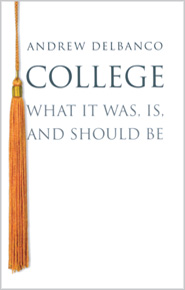
Andrew Delbanco. Princeton, NJ & Oxford, UK: Princeton University Press, 2012; 240 pp; ISBN: 978-0-69113-073-6, cloth $24.95 USD.
Reviewed by William Bruneau
Andrew Delbanco is a biographer of Herman Melville, a well-reputed historian of American ideas, a successful essayist, and professor of English at Columbia. His new book on the American four-year liberal arts college calls on all these competencies. It is good reading from beginning to end.
Delbanco wants a renaissance in undergraduate education. He proposes renewed commitment to humane and transformative higher education. For inspiration he reaches back to the 17th and 18th centuries. An early version of the college “in its essentials” arose in the American colonies around about 1660. When Delbanco says “essentials,” he means it. Religious education was once the point of the college. By the middle of the 19th century, it wasn’t any longer. Still, the essentials remain if we look hard for them. The book tells what those essentials are.
Delbanco connects present-day colleges to a time when religious ideas still had a certain resonance in American society. He quotes Emerson’s remark that “it is not instruction, but provocation, that I can receive from another soul.” (p. 62) Mind you, for Delbanco, college education invokes humane scepticism in student and teacher alike.
This is hardly a religious outlook, and yet it is a view that gives an enhanced appreciation of the natural world, and provokes a “sense of ethical responsibility.” (p. 3) It relies on close relations between teachers and pupils (closer than is possible in large classes or in massive open online courses). Its success depends on small classes, on the power of the spoken word, on collaborative and “lateral” teaching. It leaves space for community service from the very beginning of a student’s time at college.
So far Delbanco’s book sounds unexceptional, but College is far from a run-of-the-mill nostalgia-laden reminiscence.
The book asks readers to agree that the last three centuries of American higher education are a pedagogical and intellectual resource bank for the college of the 21st century. Delbanco knows organized religious belief no longer has significant power, yet he is convinced the emotional and aesthetic claims of college education are very much with us, and some of those took form in a religious time. The religious apparatus has simply fallen away.
Some unpleasant features of the American past remain. Delbanco worries about social exclusivity even in an age of student loans and grants. Social-racial discrimination is a disconcerting presence in the American college. Americans shouldn’t be surprised. They’ve been here before, Delbanco says.
This takes us to a second distinguishing feature of College. Delbanco thinks that even if colleges are more open and accepting than before, the society that made them now threatens to unmake them. In an age of university rankings, performance indicators, and vocationalism, the college is having a tough time. Modernity has come to the United States, but it has come at a high price — a crisis of identity, purposes, governance and finance is upon the college.
One self-evident answer to problems outlined in College would be a massive increase in public funding, along with a decrease in the “marketization” that afflicts institutions across the U.S. and all OECD countries. The performance indicators that excuse huge course loads and undemanding course sequences in so-called “interdisciplinary” degrees must be tamed. Tuition fees must be frozen or eliminated.
For some time to come, most American students will arrive unprepared for higher education, so Delbanco calls for remedial instruction to help them. To the extent the digital revolution may reduce the distance between the haves and the have-nots, a sceptical Delbanco can imagine spending money on it, too. He is something of an egalitarian.
But in the short, medium, and long terms, the best solutions involve the greatest expense of all: hiring and paying full-time academic staff, disentangling the college from the market.
Delbanco returns again to his theme: “many academics have a curiously uneasy relation with these (pre-19th-century) origins, as if they pose some threat or embarrassment to our secular liberties, even though the battle for academic freedom against clerical authority was won long ago.” (p. 65)
He wants us to remember that college has been a trainer of public servants as much as a creator of ministers and pastors, as close to democratic politics as it has been a friend of business.
The great purpose of education in a democracy is to reach all people, and not “to presume that education should be reserved for the wellborn and the well-off.” (p. 171) Pushed to its limits, this is an egalitarian formula for educational reform.
For non-American readers, Delbanco’s book leaves important, unanswered questions. The biggest is the matter of governance. He observes that “At Columbia, in the twenty years since the dissolution of the college faculty as a distinct entity … I am aware of only one faculty meeting where substantive discussion of undergraduate education took place.” (p. 91)
At my own university, the last such discussion in the academic senate occurred in 1969. It seems Delbanco’s point is valid north of the border. Surely if serious discussion is to come, it must involve university teachers, not just clients and managers.
Governance in the American system is no longer shared, if it ever was. Marketers and bureaucrats have displaced teachers and even their student-clients. There is a serious risk to academic freedom when markets and bureaucrats can insist that tenure is trivial, and that strong contracts are an annoyance, especially if they are arrived at collectively. But without them, Delbanco’s goals cannot be reached without a fundamental reform of governance.
Despite these weaknesses, the book reaches its objectives. Its research base is impeccable, as is its expository form. It deserves a place in every college and university library, and not just in the U.S.
---------------------------------------------------------------
William Bruneau is professor emeritus at the University of British Columbia.